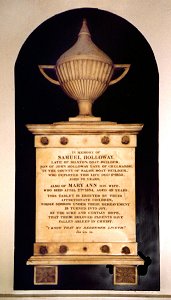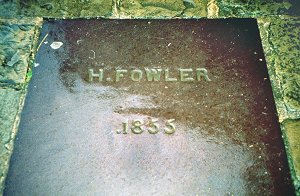HENRY FOWLER OF BILSTONby Judith GloverWebmaster's note: Judith Glover is the great-great-great-niece of Henry Fowler. Judith is a professional writer who began her writing career with the Express and Star and the old Wolverhampton Chronicle. Amongst her many publications are nine novels, three of which have a strong Wolverhampton setting: Tiger Lilies (1991), Minerva Lane (1994) and Pride of Place (1995) and another, Mirabelle (1992) is set partly in Wolverhampton. Judith has a web site, "Dog Bite Old Roper: a Midlands Genealogy", showing her family tree, at: The members of the various branches of this family seem to have had archetypal Bilston and Black Country lives and are worth examining from that point of view alone. Note that this Henry Fowler is from a quite different family from the Fowlers who married into the Thorneycroft family. Henry Fowler, colliery proprietor, iron-master and self-made millionaire, was born at Bilston in 1820, the oldest son of Thomas and Ann Fowler. His father, a japanner and licensed victualler, kept the Old Crown pub in Bridge Street from the early 1820s until his death in 1841. His mother, Ann Shale, was the daughter of William Shale and both families had lived in Bilston for many generations. A directory of 1841 recorded Henry’s newly-widowed mother as publican of the Roebuck in Bridge Street; and the census for that year showed Henry still living at home with his younger brothers and sisters. By the time of the 1851 census the Fowlers had moved to Church Street in Bilston, where Ann Fowler was now publican of another premises, probably the Horse and Jockey, which remained associated with the family well into the 1890s. Henry, now aged 30, was still unmarried. The census gives his occupation as a timber merchant’s clerk, and it seems likely that his employer was his uncle by marriage, Samuel Holloway, a victualler and boat builder, who had been recorded as publican of the Horse and Jockey in both 1818 and 1834.
Samuel Holloway had married Ann Fowler’s sister, Mary Ann Shale, in 1805. One of their children was Eliza, born in 1814. In 1851 she, like her cousin Henry Fowler, was still unmarried - the census for that year gave her age as 38 and her occupation as ‘retired victualler’. Despite the fact that they were so closely related, Henry and Eliza became betrothed, and their marriage took place at St Leonard’s church, Bilston, on 29 April 1852. Their only surviving child was William Henry Fowler, born in the spring of the following year (a second son, Samuel Thomas, died in infancy in 1856). By 1861 Henry Fowler had become a business partner of his uncle William Shale, a Bilston colliery owner, and his fortunes were taking an upward turn: that year’s census described him as a coal-master, living at Hockley Cottages, Coseley, with his wife Eliza and their young son William Henry. By the end of 1868, following his uncle Shale’s death, Henry had also become an iron-master, being identified as such when he acted as executor of his uncle’s Will. This change of fortune was tied in with the Shale family’s own prosperity: Bilston properties mentioned in that Will include four houses in Broad Street and four houses in Tibbetts Croft (these were left jointly to Henry and one of his brothers), one house in Bilston Street, one house in Cold Lanes, a parcel of land known as Turnpike Piece in Bilston, a house and land at Penn, and two houses and seven acres of land at Hockley which had been purchased jointly with Henry Fowler some years previously. The Shale estate also included Barbor’s Field furnaces and collieries, which Henry inherited, and Ettingshall Ironworks. In all, the residue of the estate amounted to just under £14,000 – or just over one million pounds at today’s value. Sometime during the first half of the 1860s Henry Fowler acquired ownership of three public houses in Skidmore Row (now Skidmore Road) at Coseley - The Black Horse, The Old Bush, and The Ship & Rainbow. These premises were quite likely ale and provisions shops for the workers at his Barbor's Field furnaces. We know that Henry had moved away from Hockley around this time, since details of one acquisition in 1865 describe him as an iron-master of Tettenhall. An 1869 list of Bilston mines includes Bunkers Hill and Middlefield, both shown owned by William Shale, and Highfield and Bloomfield (Tipton), both owned by Fowler & Co. Years later Henry Fowler was to honour his Shale relations by donating a memorial window to All Saints church, Sedgley. Sited on the north side of the nave, it reads:
Sometime before 1871 Henry Fowler decided to move away from Bilston and purchased a property in one of the most expensive residential areas of Wolverhampton - Stockwell End at Tettenhall. The census for that year recorded him as now aged 50, an iron-master employing 100 persons, living at Clifton Road together with his 58-year-old wife Eliza and his son William Henry, who at 17 was still a scholar. A housekeeper and one domestic servant looked after them. Within ten years the family had moved again, this time to a villa on the Compton Road, and on the 1881 census Henry was described as an iron-master and colliery proprietor, while his still unmarried son appeared to have no occupation. The family was to move once more, this time to The Limes at Sedgley, and it was here on 18 July 1885 that Henry Fowler died of congestion of the brain. He left £39,557 12s 1d (gross) which at today’s value approximates £3,500,000. Although he had already purchased a family vault beneath the paving outside St Leonard’s church porch at Bilston (in fact this vault was used for Fowler burials for a hundred years up until the 1950s) Henry chose to be buried in the crypt of All Saints’ at Sedgley, in a small vault purchased the year before his death.
After making generous provision for his widow Eliza (though she outlived him by only a short time), Henry left his entire estate to his son, William Henry, who at the age of 32 was now a very eligible bachelor. On the 1891 census he was described as living on his own means, and there is a probability that besides owning a good deal of property he was co-owner of a company named Plascom Ltd., in Wolverhampton, manufacturers of road-surfacing composition. Sometime before 1893 William Henry began courting a young woman who worked at the Star and Garter hotel in Victoria Street. Her name was Jessie Margaret Macdonald, she was in her mid-twenties, and despite her Scottish name she came from Cheltenham in Gloucestershire. Her background was very different from that of her wealthy suitor: her widowed mother took in lodgers and her sister worked as a barmaid. Nonetheless, future events prove her to have been of an honest, loyal and loving character. William Henry Fowler married Jessie Macdonald on 11 April 1893 at Cheltenham. The marriage certificate gives his address as The Limes, Sedgley, the handsome property purchased by his father early in the 1880s (it was later owned by Dudley Council, and having been almost derelict for some years has now been converted into eight luxury apartments). The census of 1901 showed the Fowlers living at Cheltenham with Jessie’s mother and unmarried sister, Emma, at a house called ‘Louieville’ in Western Road, and this was to be their home for the rest of their married life, though sadly there would never be any children to fill its nursery. In a codicil to his Will, dated November 1916, four years before his death, William Henry left £3,000 (approximately £170,000 at today’s value) to his sister-in-law Emma, and £1,000 (£56,000) to his cousin, my great-grandfather, John Fowler. Apart from a generous bequest of property to another cousin, Thomas Shale, the rest of his estate passed entirely to Jessie his wife. It demonstrates her qualities as a spouse that Jessie carried out his wishes to the full, and it is worth reproducing here her own Will, dated 1921 (and which she never changed, although she died thirty years later) which benefited Wolverhampton to such a great extent.
The total value of these charitable bequests was £39,000, which amounts to roughly £1,800,000 today. Incidentally, one of the many boys who received an education at The Royal Orphanage (now the Royal Wolverhampton School) through the W. H. Fowler University Scholarship was the noted broadcaster and TV personality Gilbert Harding; and the William Henry Fowler Playing Fields at Bushbury are still providing recreation for new generations of youngsters. As a rather sad little end-note, Jessie Fowler died in 1951 alone and in tragic circumstances at ‘Louieville’, her home in Cheltenham. Her body was discovered on 3 December, and following an inquest, cause of death was given as ‘carbon monoxide poisoning, there being insufficient evidence to show how it became inhaled’. Her age was given as ‘about 87 years’. Her body was brought back to Sedgley to be interred in the crypt of All Saints' church beside the remains of her husband William Henry Fowler and his parents Henry and Eliza. |


